A Small Town’s Large Research on the Health of the Seas
This post is the sixth in our series celebrating World Oceans Day on June 8. This series explores publications that represent important milestones in the progress of marine bioscience research and ocean exploration.
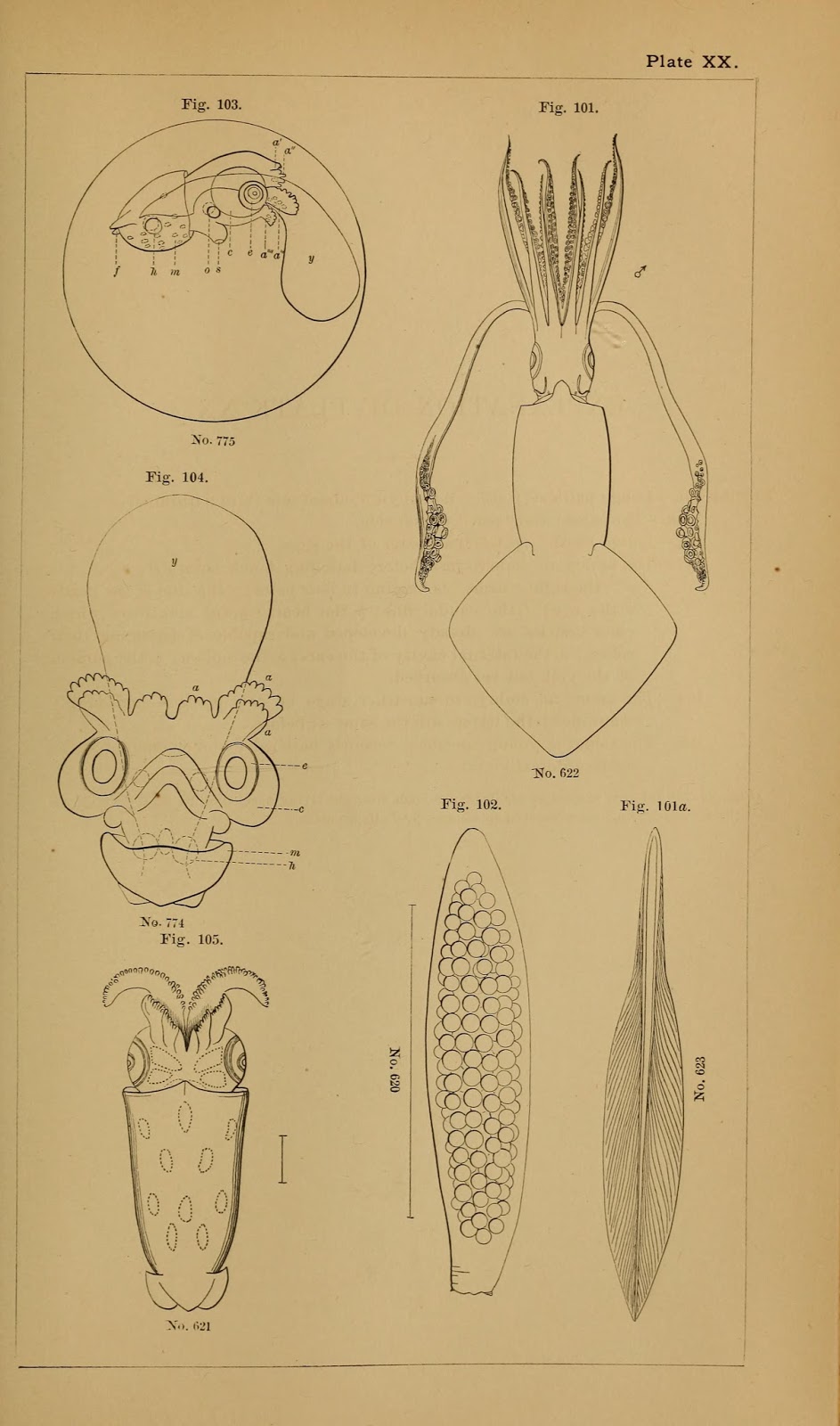 |
| Squid have been a major marine organism model in Woods Hole for almost 150 years. Report on the conditions of the sea fisheries of the south coast of New England. 1873. http://biodiversitylibrary.org/page/36088064. |
When whaling and fertilizer manufacturing ended in the latter half of the 19th century in the quaint village of Woods Hole, Massachusetts, the town turned to research, growing quickly into a world renowned center for marine science. In 1871, the U.S. Commission of Fish and Fisheries (the antecedent of the National Marine Fisheries Service), founded by the Secretary of the Smithsonian Institution Spencer Fullerton Baird, published Report on the conditions of the sea fisheries of the south coast of New England. This report notes the recently passed “Joint resolution for the protection and preservation of the food-fishes of the coast of the United States”, which recognized that the nation’s fishing resources were not endless. Commissioner Baird realized the need to develop fisheries management plans to balance once abundant fisheries populations with the competing needs of the human population. The volume also created a baseline inventory of marine species and fishing techniques in and around Cape Cod and the east coast of the United States.
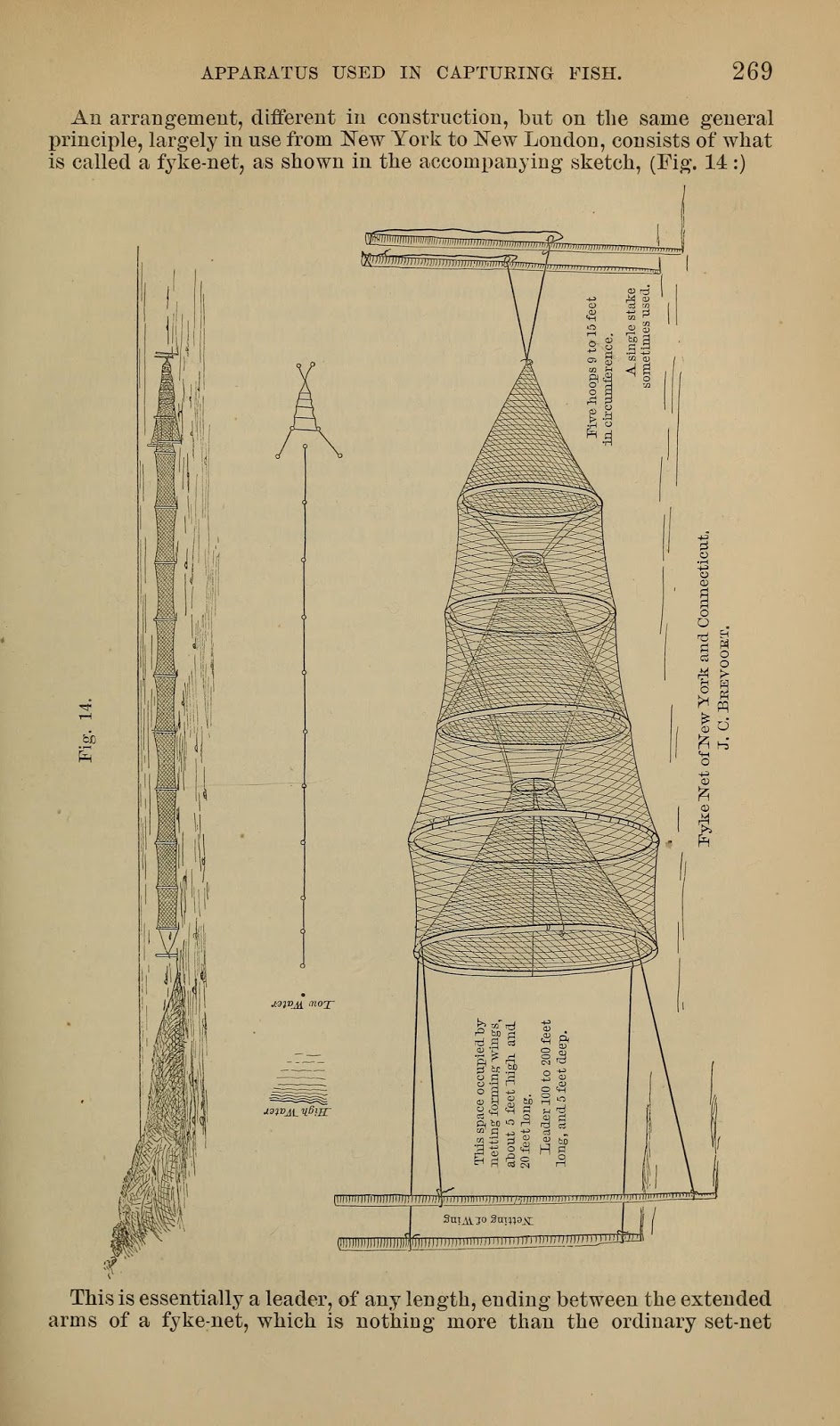 |
| Commercial fishing net used in the 1870s. Report on the conditions of the sea fisheries of the south coast of New England. 1873. http://biodiversitylibrary.org/page/36087402. |
By the late 1880’s, what is now the oldest continuously operating private marine laboratory in the United States, the Marine Biological Laboratory (MBL), had been founded, with its scientists publishing the journal Biological Bulletin. The Biological Bulletin v.67 (1934) contains an article written by biologists August Krogh and Ancel Keys entitled Methods for the determination of dissolved organic carbon and nitrogen in sea water. The development of accurate ways to measure nitrogen concentrations in non-fresh water was critical to understanding eutrophication, a condition where excess nutrients result in algal blooms and fish kills. Eutrophication is at the forefront of many studies related to the health of our oceans, including the “dead zone” in the Gulf of Mexico and many coastal waters.
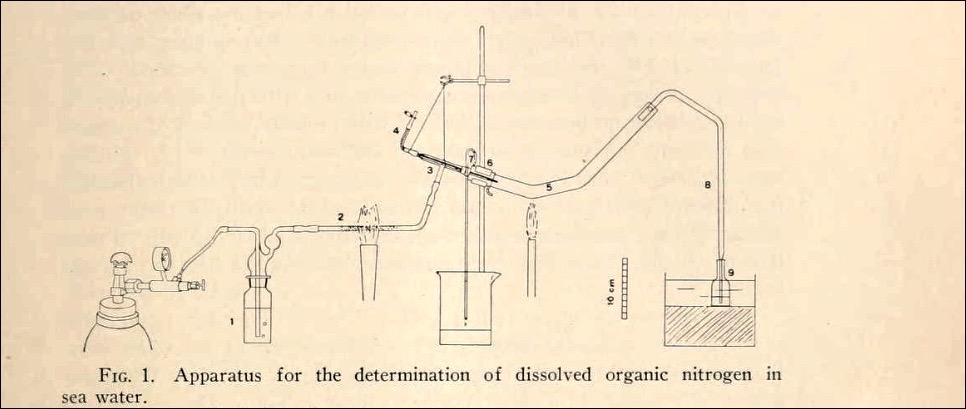 |
|
August Krogh’s and Ancel Keys’ apparatus for the determination of dissolved organic nitrogen in sea water. The Biological Bulletin. v. 67 (1934). http://biodiversitylibrary.org/page/1441636.
|
With the National Marine Fisheries Service studying marine fisheries in Woods Hole and the Marine Biological Laboratory focusing on marine biology and cell science, the Woods Hole Oceanographic Institution (WHOI) was founded in 1930 to study the still developing field of the oceanographic sciences. In 1952, WHOI began publishing a magazine/journal called Oceanus. One of the first articles published in volume 1 of Oceanus highlights the discovery of new fishing grounds off of the northeast U.S. coast, and the abundance of never before seen species.
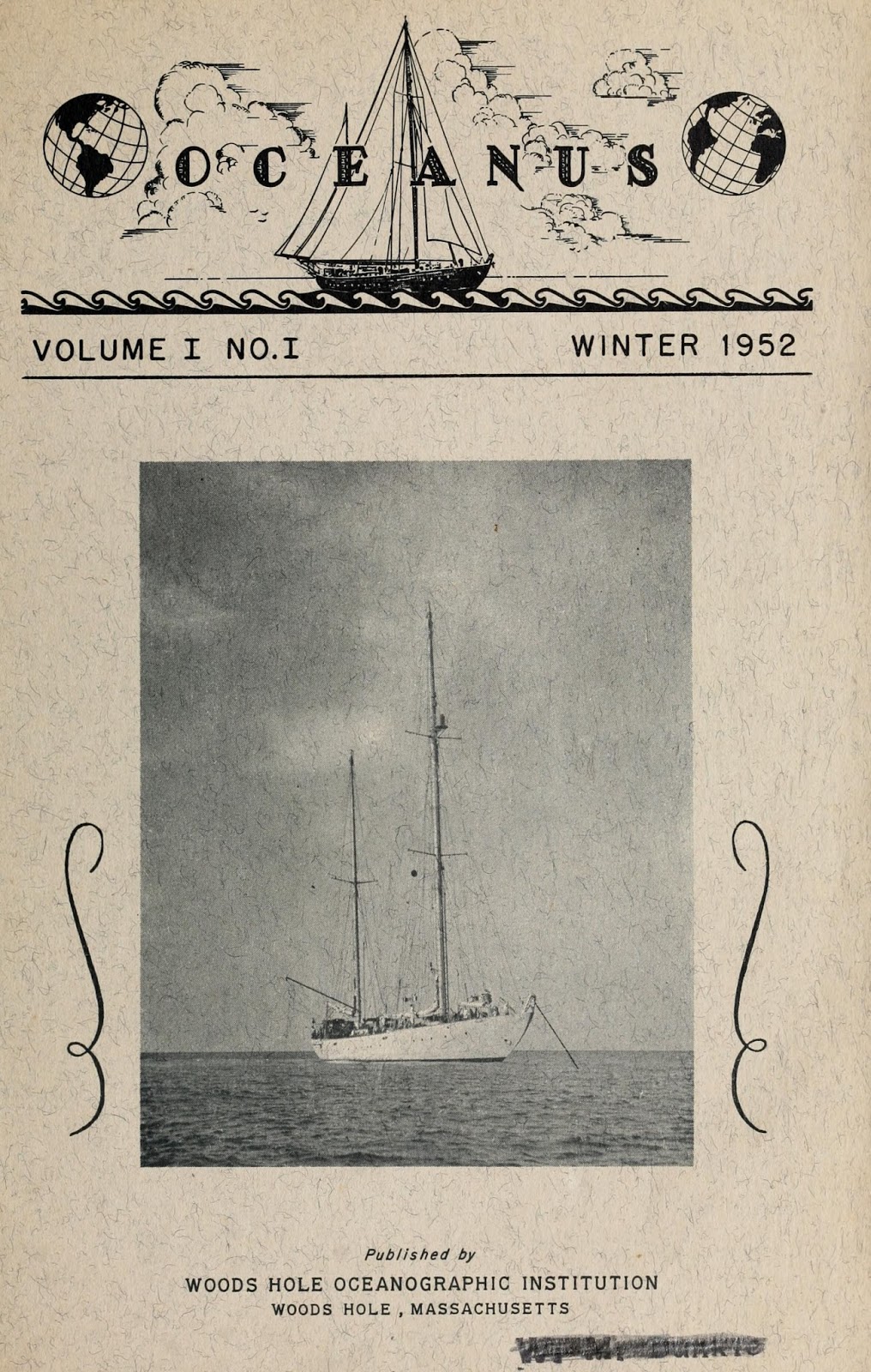 |
|
Volume 1, number 1 of Oceanus, a photo of the WHOI research vessel Atlantis. Oceanus. v. 1, n. 1 (1952). http://biodiversitylibrary.org/page/1555338.
|
Fifty one volumes later, Oceanus continues to publish issues in both print and online formats, and issues archived online from 1952-2007 can also be viewed through the Biodiversity Heritage Library. As the course of the history of the Woods Hole Oceanographic Institution has revolved around ocean exploration and studying the health of the oceans, so also has the subject matter of Oceanus, which has diligently reported on the fascinating work performed by Woods Hole scientists.
For example, in volume 44 issue 1 (2005) of Oceanus, an announcement was made of the establishment of the Woods Hole Center for Oceans and Human Health, a collaboration between WHOI, MBL, and the Massachusetts Institute of Technology. Over the last decade Oceanus has reported on this important collaboration many times, and in the above mentioned article WHOI physical oceanographer and Senior Scientist Dennis McGillicuddy said: “The ocean is a turbulent fluid medium that’s changing all the time…In order to make significant progress in health concerns, we have to grapple with how physics, biology, and chemistry intersect and interact. It’s really a fundamentally new direction for this research.” The author of this article, Andrea Baird, wrote: “Human health and welfare are intimately tied to the oceans. Fisheries yield 130 million tons of food each year, while biologists and chemists continue to uncover useful medicinal compounds among the snails, sponges, and other marine creatures. At the same time, exploding populations of toxic algae cause respiratory problems and shellfish poisoning, as sewage and runoff fill coastal waters with contaminants that poison fish and infect swimmers.”
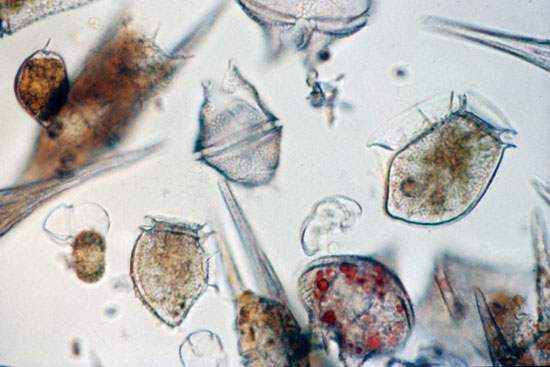 |
|
Phytoplankton like these produce harmful algal blooms. Sengco, Mario. Oceanus. v. 43, no. 1 (2004). http://www.whoi.edu/oceanus/feature/a-fatal-attraction-for-harmful-algae. Photo by Don Anderson, courtesy of WHOI.
|
Since the 1970’s scientists at sea have reported seeing massive amounts of bits and pieces of plastics in the North Atlantic Ocean in the Sargasso Sea, an area bordered by the Gulf Stream, the North Atlantic Current, the Canary Current, and the North Equatorial Current. Oceanus in 2010 and 2013 published articles detailing a collaborative project concerning these human produced plastics, which was funded by the Woods Hole Center for Oceans Health, and conducted by three Woods Hole research institutions: the MBL, the Sea Education Association (SEA), and WHOI. SEA, which runs an undergraduate semester at sea program, has been collecting samples of plastics floating on the Sargasso Sea since 1986.
In the 2010 Oceanus article, Plastic Particles Permeate the Atlantic: Scientists find new clues about what happens to plastics in the ocean , v. 48, no. 2 (2010), author Dave Lawrence speaks of the history of scientists learning of the existence of these plastics. Lawrence says: “The plastic particles showed evidence of being coated with living organisms. Are microbes or other tiny life forms digesting the plastics, causing them to sink, or are they sticking to the particles and being carried through the ocean like sailors on rafts?”
 |
|
Most of the Sargasso Sea plastics collected by Woods Hole scientists are tiny shards. Lawrence, Dave. Oceanus. v. 48, no. 2 (2010). http://www.whoi.edu/oceanus/feature/plastic-particles-permeate-the-atlantic. Photo by Tom Kleindinst, courtesy of WHOI.
|
In the 2013 Oceanus article, Behold the ‘Plastisphere’: Colonies of microbes flourish on tiny bits in the ocean v. 50, no. 2 (2013), Oceanus Editor Lonny Lippsett details results produced by an analysis of the plastics. While humans are responsible for the placement of plastics in the ocean, different microbes live on the plastics, some consuming the plastics, while others are toxic disease causing bacteria. Lippsett wrote: “Using scanning electron microscopy and gene sequencing techniques, they found at least 1,000 different types of bacterial cells on the plastic samples, including many species yet to be identified. The colonies included plants, algae, and bacteria that manufacture their own food (autotrophs), animals and bacteria that feed on them (heterotrophs), predators that feed on these, and other organisms that establish symbiotic relationships. These complex communities exist on plastic bits hardly bigger than the head of a pin, and they have arisen with the explosion of plastics in the oceans in the past 60 years.” Lippsett also quotes MBL scientist Linda Amaral-Zettler: “We’re not just interested in who’s there. We’re interested in their function, how they’re functioning in this ecosystem, how they’re altering this ecosystem, and what’s the ultimate fate of these particles in the ocean,” Amaral-Zettler said. “Are they sinking to the bottom of the ocean? Are they being ingested by other organisms? If they’re being ingested, what impact does that have?”
Whether establishing concerns about the health of fisheries stocks and human consumption in the late 1800’s, detailing a new methodology for the study of nitrogen levels in the ocean in the 1930’s, or studying the impact of plastics on the health of the ocean, all of this research is united through time as trying to make the world, the oceans, and humanity a healthier place.
The MBLWHOI Library began collecting science literature when the Marine Biological Laboratory came into existence in 1888, and it has been the main library serving the Woods Hole scientific community, including all of the institutions mentioned in this post. The MBLWHOI Library is a founding member the Biodiversity Heritage Library, scanning over 12,000 volumes, including the publications mentioned herein, since 2007.
More World Oceans Day Resources
- Follow us on Twitter, Facebook, and this blog all this week as we explore marine biodiversity and awesome related publications in BHL.
- Check out some monumental publications in historic and present-day marine bioscience research in our BHL collection.
- Browse a selection of marine biodiversity illustrations in Flickr and Pinterst





Leave a Comment